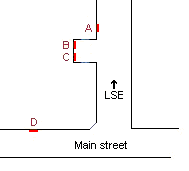I hereby present John’s Not Particularly Innovative Taxonomy Of Bank Failures ™. In increasing order of severity:
Category 1) A pure liquidity crunch — traditionally a bank run — when, by any measure, the bank remains entirely solvent and cash-flow positive;
Category 2) A liquidity crunch and insolvent (assets minus liabilities excluding shareholder equity is negative) according to market prices, but solvent according to hold-to-maturity modeling and cash-flow positive;
Category 3) A liquidity crunch and insolvent according to both market prices and hold-to-maturity modeling, but still cash-flow positive;
Category 4) A liquidity crunch, insolvent and cash-flow negative, but likely to be cash-flow positive in the near future and remain so thereafter; and, finally,
Category 5) A liquidity crunch, insolvent and permanently cash-flow negative.
A category 1 failure is easily contained by a lender of last resort and should be contained: the bank, after all, remains solvent and profitable. Furthermore, a pure liquidity crunch, left unchecked, will eventually push a bank through each category in turn and, more broadly, can spill over to other banks. There need be no cost to society of bailing out a category 1 failure. Indeed, the lender of last resort can make a profit by offering that liquidity at Bagehot‘s famous penalty rate.
A category 2 failure occurs when the market is panicking and prices are not reflecting fundamentals. A calm head and temporarily deep pockets should be enough to save the day. A bank suffering a category 2 failure should probably be bailed out and that bailout should again be profitable for whoever is providing it, but the authority doing to bailing needs be very, very careful about that modeling.
For category 1 and 2 failures, the ideal would be for a calm-headed and deep-pocketed private individual or institution to do the bailing out. In principle, they ought to want to anyway as there is profit to be made and a private-sector bailout is a strong signal of confidence in the bank (recall Warren Buffett’s assistance to Goldman Sachs and Bank of America), but there are not many Buffetts in the world.
Categories 3, 4 and 5 are zombie banks. Absent government support, the private sector would kill them, swallow the juicy bits and let the junior creditors cry. If the bank is small enough and isolated enough, the social optimum is still to have an authority step in, but only to coordinate the feast so the scavengers don’t hurt each other in the scramble. On the other hand, if the bank is sufficiently important to the economy as a whole, it may be socially optimal to keep them up and running.
Holding up a zombie bank should optimally involve hosing the bank’s stakeholders, the shareholders and the recipients of big bonuses. Whether you hose them a little (by restricting dividends and limiting bonuses) or a lot (by nationalising the bank and demonising the bonus recipients) will depend on your politics and how long the bank is likely to need the support.
For a category 3 failure, assuming that you hold them up, it’s just a matter of time before they can stand on their own feet again. Being cash-flow positive, they can service all their debts and still increase their assets. Eventually, those assets will grow back above their liabilities and they’ll be fine.
For a category 4 failure, holding them up is taking a real risk, because you don’t know for certain that they’ll be cash-flow positive in the future, you’re only assuming it. At first, it’s going to look and feel like you’re throwing good money after bad.
A category 5 failure is beyond redemption, even by the most optimistic of central authorities. Propping this bank up really *is* throwing good money after bad, but it may theoretically be necessary for a short period while you organise a replacement if they are truly indispensable to the economy.
Note that a steep yield curve (surface) will improve the cash-flow position of all banks in the economy, potentially pushing a category 5 bank failure to a category 4 or a 4 back to a 3, and lowering the time a bank suffering a category 3 failure will take to recover to category 2.
